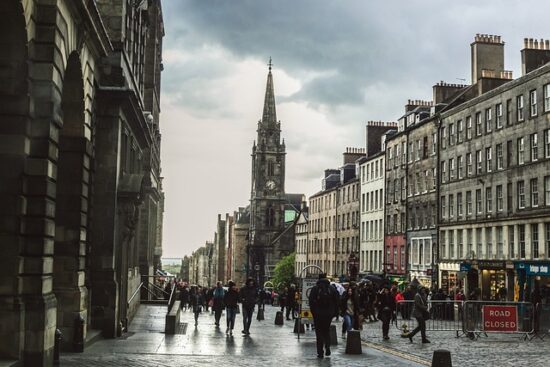As the capital of Scotland, Edinburgh is one of the most populous and most internationally competitive cities in the United Kingdom. Aside from its economic success, the city is valuable spot for medieval history.
The Royal Mile is the main thoroughfare in the old section of Edinburgh. It is composed of succeeding streets that have been in existence since the medieval times. Its location is also very distinct as it extends to the eastern side of a former active volcano. The major sections that belong to this popular thoroughfare are Lawnmarket, High Street, Abbey Strand, and Cannongate.

The Royal Mile is a fascinating area full of history and traditional architecture that bring you closer to the complexities of Scotland’s past. The timber buildings around it were traditionally named after their owners and have gaps between them, which are called “closes”. Although, there are numerous companies that offer organized bus tours, there is no better way to truly experience this historical thoroughfare than to walk your way to its most captivating sites. If you like an edgier exploration, then you can try the ghost walk – a popular activity that allows you to explore hidden vaults and streets located underground.
Major Streets
The major streets that make up the Royal Mile are must see because they are loaded with interesting attractions. Castlehill has been in existence for about 7000 years. Paradoxically, Castlehill is also home to modern structure Camera Obscura and the World of Illusions. This structure features a gigantic camera taking images of its surroundings.
Lawnmarket is a former open trading market that was called Via Regis, which means the Way of the King. It houses the nicest preserved buildings in the Old Town, which include the Lady Stair’s House and Gladstone’s Land. High Street is the usual main spot for activities like street performances during the major festivals of Edinburgh. The Parliament Square was the site for the Scottish Parliament in 1641 until 1707. Canongate’s crowd drawers are Canongate Kirk, Huntly House Museum, and the 17th century Canongate Church; whose churchyard is the holds the graves of famous personalities.
Edinburgh Castle
Aside from being the seat of power for Scottish royalty, the Edinburgh castle is a reminder of Scotland’s war efforts for independence. The castle is elevated so climbing to see it also gives the special treat of seeing beautiful views of the city. For more than 2000 years, it became an imposing fortification. Today the castle serves as military headquarters for the Scottish Division. Must-see attractions within the castle grounds are St. Margaret’s chapel, the Great Hall and the Crown Square, the Witches Well and the Crown room, which keeps the precious Scottish crown jewels. Just by walking a few meters from the castle, you will discover the Scottish National War Museum.
Holyrood Palace
The Royal Palace of Holyroodhouse was built beside the Abbey of the Holy Rood in the 16th century. The Augustinian monastery of Holyrood Abbey once stood in the place of this palace. Holyrood has a countryside appeal to it, despite being located in a highly urbanized city. When it is not used for royal functions, some sections are open for guided tours. Some of the sections worth seeing are the State Apartments, the Great Gallery and the Morning Drawing Room.
